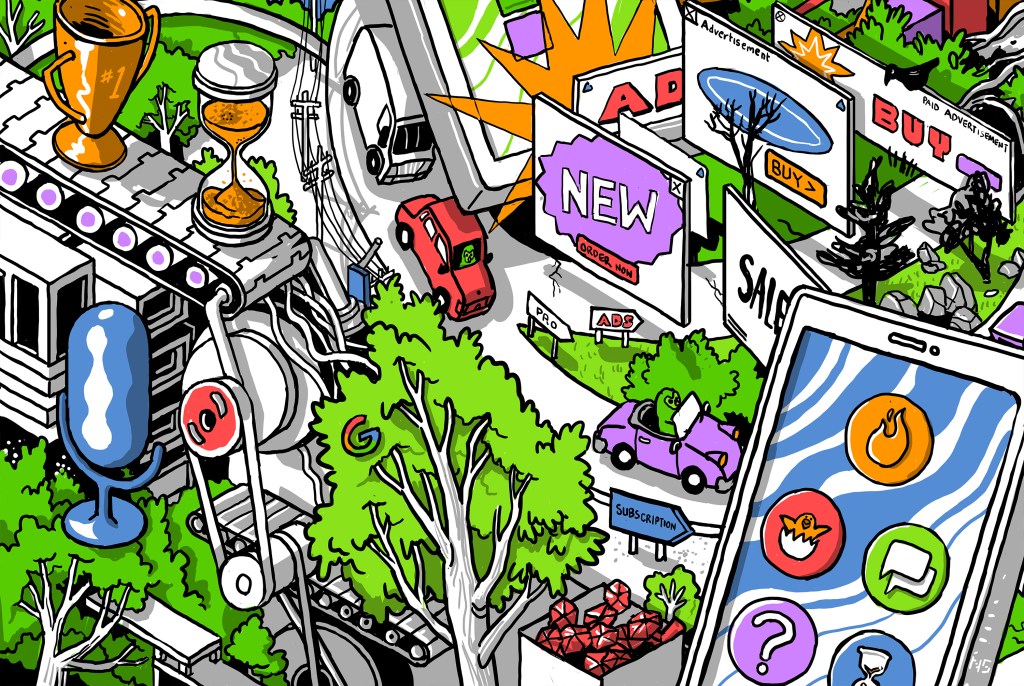Duolingo has been wildly successful. It has pulled in 500 million total registered learners, 40 million active users, 1.5 million premium subscribers and $190 million in booked revenues in 2020. It has a popular and meme-ified mascot in the form of the owl Duo, a creative and engaging product, and ambitious plans for expansion.There’s just one key question in the midst of all those milestones: Does anyone actually learn a language using Duolingo?
“Language is first and foremost a social, relational phenomenon,” said Sébastien Dubreil, a teaching professor at Carnegie Mellon University. “It is something that allows people to make meaning and talk to each other and conduct the business of living — and when you do this, you use a tone of different kinds of resources that are not packaged in the vocabulary and grammar.”
Duolingo CEO and co-founder Luis von Ahn estimates that Duolingo’s upcoming product developments will get users from zero to a knowledge job in a different language within the next two to three years. But for now, he is honest about the limits of the platform today.
“I won’t say that with Duolingo, you can start from zero and make your English as good as mine,” he said. “That’s not true. But that’s also not true with learning a language in a university, that’s not true with buying books, that’s not true with any other app.”
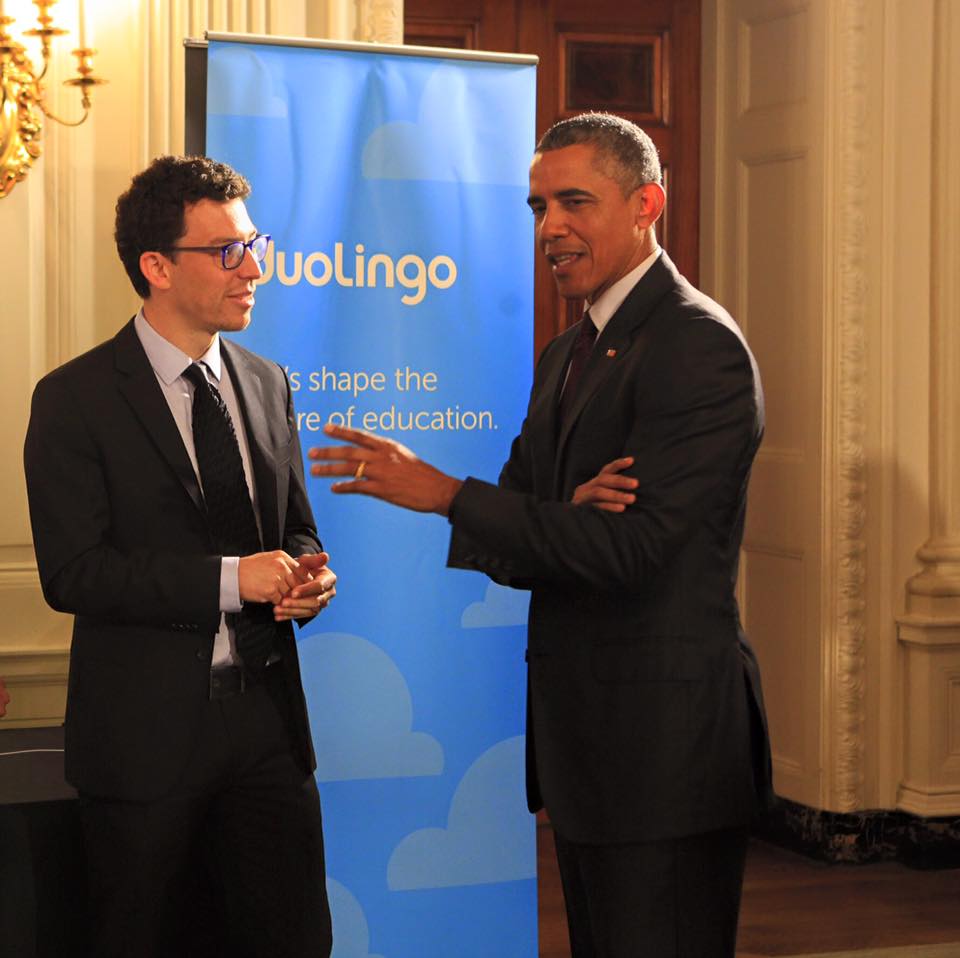
While Dubreil doesn’t think Duolingo can teach someone to speak a language, he does think it has taught consistency — a hard nut to crack in edtech. “What Duolingo does is to potentially entice students to do things you cannot pay them enough time to actually do, which is to spend time in that textbook and reinforce vocabulary and the grammar,” he said.
That’s been the key focus for the company since the beginning. “I said this when we started Duolingo and I still really strongly believe it: The hardest thing about learning a language is staying motivated,” von Ahn said, comparing it to how people approach exercise: it’s hard to stay motivated, but a little motion a day goes a long way.
With an enviable lead in its category, Duolingo wants to bring the quality and effectiveness of its curriculum on par with the quality of its product and branding. With growth and monetization secured, Duolingo is no longer in survival mode. Instead, it’s in study mode.
Tech and VC heavyweights join the Disrupt 2025 agenda
Netflix, ElevenLabs, Wayve, Sequoia Capital — just a few of the heavy hitters joining the Disrupt 2025 agenda. They’re here to deliver the insights that fuel startup growth and sharpen your edge. Don’t miss the 20th anniversary of TechCrunch Disrupt, and a chance to learn from the top voices in tech — grab your ticket now and save up to $675 before prices rise on August 7.
Tech and VC heavyweights join the Disrupt 2025 agenda
Netflix, ElevenLabs, Wayve, Sequoia Capital — just a few of the heavy hitters joining the Disrupt 2025 agenda. They’re here to deliver the insights that fuel startup growth and sharpen your edge. Don’t miss the 20th anniversary of TechCrunch Disrupt, and a chance to learn from the top voices in tech — grab your ticket now and save up to $675 before prices rise.
In this final part, we will explore how Duolingo is using a variety of strategies, from rewriting its courses to what it dubs Operation Birdbrain, to become a more effective learning tool, all while balancing the need to keep the growth and monetization engines stoked while en route to an IPO.

“Just a funny game that is maybe not as bad as Candy Crush.”
Duolingo’s competitors see the app’s massive gamification and solitary experience as inherently contradictory with high-quality language education. Busuu and Babbel, two subscription-based competitors in the market, both focus on users talking in real time to native speakers.
Bernhard Niesner, the co-founder and CEO of Busuu, which was founded in 2008, sees Duolingo as an entry-level tool that can help users migrate to its human-interactive service. He thinks that Duolingo has limitations that would barr users from getting fully fluent.
“And that’s where we come in: Our belief is that you should not be learning a language just by yourself, but [ … ] together, which is our vision,” he said. Busuu has more than 120 million users worldwide.
Duolingo has been the subject of a number of efficacy studies over the years. One of its most positive reports, from September 2020, showed that its Spanish and French courses teach the equivalent of four U.S. university semesters in half the time.
Babbel, which has sold over 10 million subscriptions to its language-learning service, cast doubt on the power of these findings. Christian Hillemeyer, who heads PR for the startup, pointed out that Duolingo only tested for reading and writing efficacy — not for speaking proficiency, even though that is a key part of language learning. He described Duolingo as “just a funny game that is maybe not as bad as Candy Crush.”
“We have 250 linguists; we don’t just translate courses,” Hillemeyer said. “What we need to do to teach an English person to understand French is different from what a German native speaker needs to understand — all these courses are created individually for the language combinations, and this is the kind of linguist nerd level of stuff.”
Language learning service Babbel says it has now sold over 10M subscriptions
Putting the ed back into edtech
One of the ironic legacies of Duolingo’s evolution is that for years it outsourced much of the creation of its education curriculum to volunteers. It’s a legacy the company is still trying to rectify.
The year after its founding, Duolingo launched its Language Incubator in 2013. Similar to its original translation service, the company wanted to leverage crowdsourcing to invent and refine new language courses. Volunteers — at least at first — were seen as a scrappy way to bring new material to the growing Duolingo community and more than 1,000 volunteers have helped bring new language courses to the app.
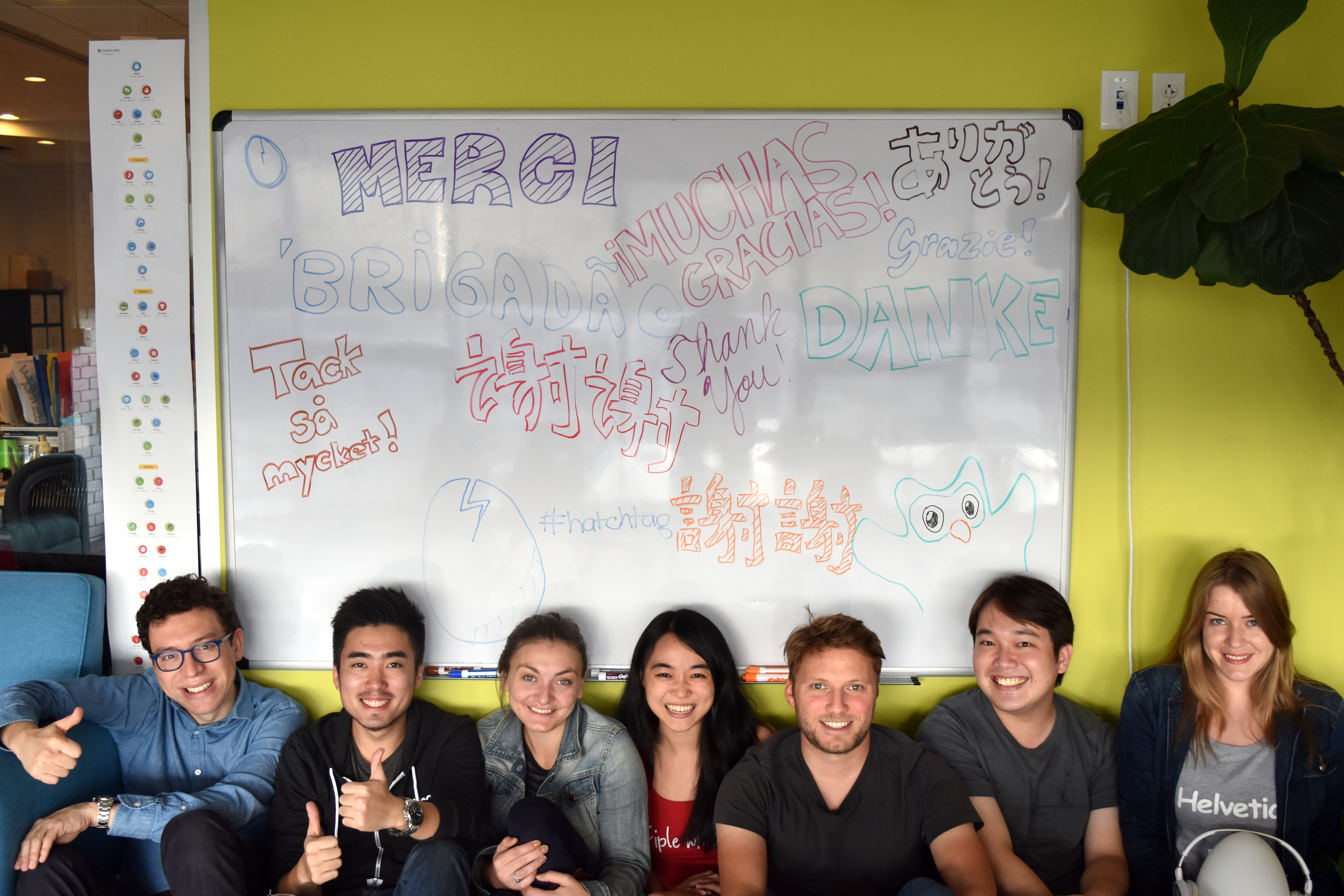
Over time, those volunteers were increasingly supported by Duolingo’s own staff. Volunteers were in charge of writing sentences and translating them as native speakers, while employees would focus on the technical side, helping design curriculums and analyze data.
It was a brilliant approach to quickly building out an extensive selection of courses, but it opened up the company to criticism — some of it quite withering — that it eschewed curated educational quality for growth and speed.
When Duolingo found a successful monetization strategy, volunteer work suddenly felt ethically questionable, in addition to the obvious concerns about content consistency. Even though no one forced people to volunteer for Duolingo, the idea that an app was bringing in bountiful revenue from courses that were partially built by volunteers left a bad taste in some mouths.
So earlier this year, Duolingo officially ended its volunteer program as a “proactive move” in doing what they saw as “right and fair.” It offered jobs to some volunteers and also launched a $4 million dollar fund for them.
As it has wound down volunteering, the company has needed to buttress its own curriculum team, which now represents 8% of its workforce. Nonetheless, the majority of Duolingo’s staff aren’t educators, with about 70% of the staff directly working on the app itself.
Simultaneously, Duolingo has had to finally perform the overdue work of rewriting its courses to fit international language learning standards, namely the Common European Framework of Reference for Languages (CEFR). Currently, only about 30% to 40% of Duolingo courses are in some stage of CEFR alignment, and on-staff curriculum designers make sure the end product aligns with both the guidelines and Duolingo’s gamification needs.
There are over 100 courses that teach 40 languages available on Duolingo, but about 75% to 80% of its users take one of the following three languages: English, Spanish or French. There is thus a big imbalance between courses trained from millions of data points and those that are much less popular. The company estimates that 74% of its U.S.-based learners and 49% of all learners worldwide are studying in a CEFR-aligned course.
“We’re figuring out how to take hundreds of these courses in-house and internally manage them and make sure they’re well taken care of,” said Karin Tsai, director of engineering, who helped launch the Language Incubator as her first project at Duolingo. “We’re still in the process of doing that but I think it’s a necessary process to go through, and I’m excited to see where we come out from the other side.”

The owl that needed a new Birdbrain
At Duolingo, if the content sits as a sedentary train, algorithms and artificial intelligence are the train conductors that decide which way to turn and reverse. Burr Settles, director of research, is the architect behind it all — from the trains to the tracks.
“The best way to learn a language is probably with a one-on-one, full-time tutor, but there’s no way in the world that everybody in the world can have access to a one-on-one tutor,” said Settles. “So we believe that AI and machine learning is the best way to scale that kind of experience to everyone.”
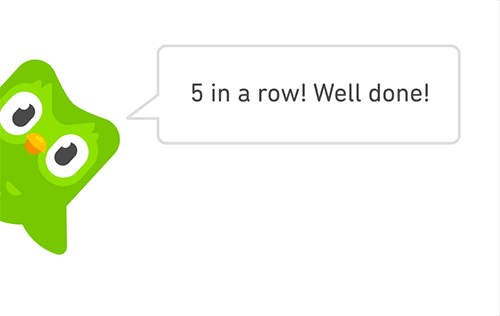
This gets back to one of Duolingo’s key challenges from part two: there’s an inherent tradeoff between guardrail metrics of user engagement and the goal of education.
“We want to make the content challenging, but we don’t make it so hard that it drives people away,” he explained. “This is the tension that has been very difficult for us: If we made things easier, they weren’t learning as well and they started to complain that it was too easy, but they stuck around longer.”
The research teams’ latest project is Birdbrain, which rolled out right as the COVID-19 lockdown hit. He describes Birdbrain as a personalized recommendation system, similar to Netflix giving movie suggestions based on viewing history. The algorithm helps Duolingo sit in the Goldilocks Zone, choosing exercises for each user based on what they got right and wrong in the past.
Before Birdbrain, Duolingo’s lessons were much more linear and random. There is a predefined set of 200 to 1,000 exercises that a user could receive while learning a skill, and a user would get 14 to 20 of those exercises somewhat arbitrarily.
“We just had a bunch of heuristics in place that tried to pick the exercises randomly and then tried to add some diversity to make sure that [the exercises] weren’t all translation challenges,” Settles said. With Birdbrain, the types of exercises offered and questions asked will still be random, but with much more intentionality. For instance, instead of a match prompt, Duolingo might suggest a type-in-from-scratch translation exercise given the user’s performance on this type of prompt in the past.
“It is one of the few things that has been able to let us break out of this cycle between the tradeoff of difficult things and engagement,” Settles said. Birdbrain is currently rolled out in all courses, but its algorithms only kick in once a user has enough historical data to make useful calculations. Currently, about 40% of all sessions every day are using Birdbrain in some way, according to the company.

How hard can Duolingo really push its students?
Birdbrain can be a win-win: It can offer a more compelling experience while also optimizing learning outcomes. But sometimes, the exercises that people need in order to learn a language are not ones they actually want to do, and it’s tradeoffs like these that can make Duolingo’s balancing act precarious.
CEO von Ahn thinks users often request aspirational features that they think they would want but will never use once implemented. One example of this is Chatbot, or a way to practice a conversation on Duolingo that would help users test speaking in a focused way. Von Ahn said that the feature was highly requested by users, but when it came time to launch, the product team soon discovered that 80% of users didn’t want to use it.
Users similarly wanted more grammar exercises, but that hurt engagement when Duolingo focused more on it contentwise. It recently rolled out immersion exercises a bit more than a week ago in an attempt to help adult learners connect dots in language beyond a vocabulary word here or there.
Finally, a big push for the company right now is what it calls Stories. Stories are short, guided dialogues with on-screen text and audio that come along with questions that test comprehension. Stories currently have 1 million daily users, and they are seen as one of the most intellectually challenging parts of the app.
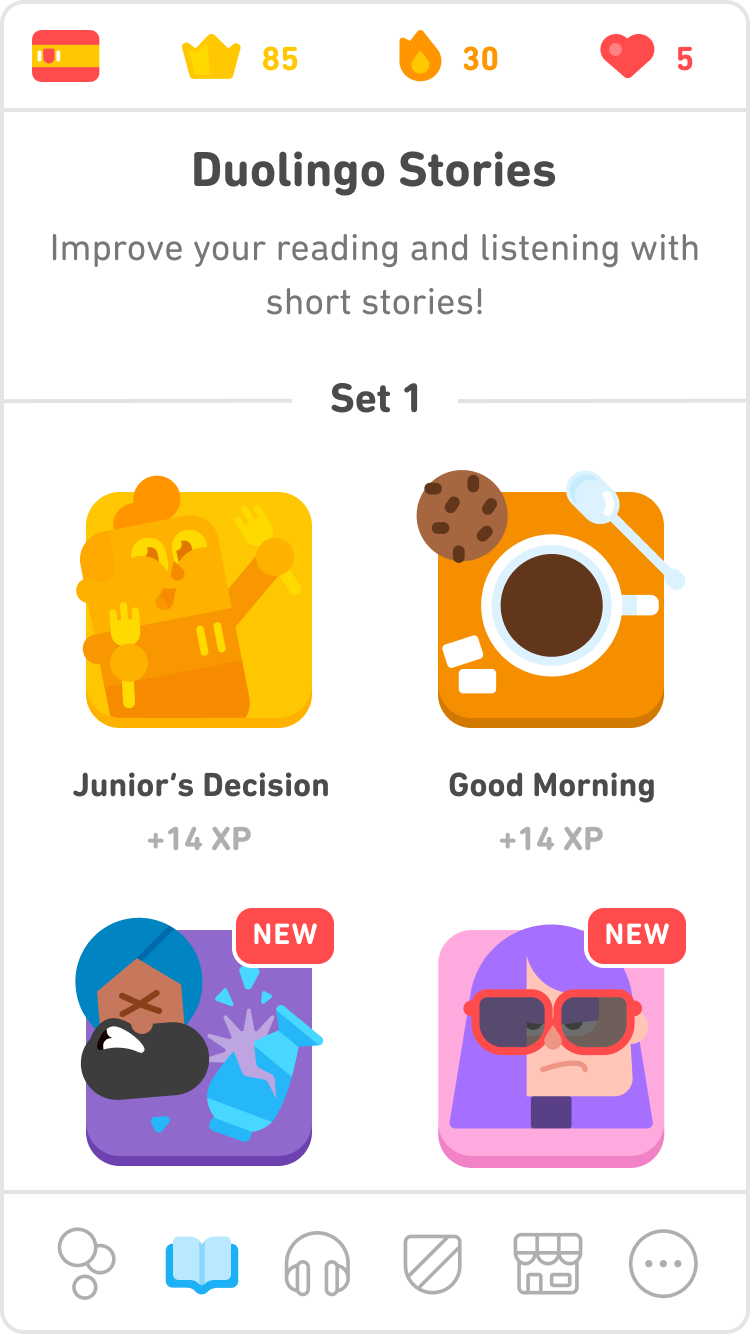
For all these new experiments though, experience has shown that users often don’t want to explore outside of Duolingo’s familiar product. The majority of users don’t visit other tabs in the app, where Stories, in-app purchases and new experiments lie. So the design team is currently testing different ways to make sure a user is naturally drawn to these functions.
Unlike a classroom where students are forced to attend, Duolingo users are choosing to learn a language. It doesn’t have the authority to direct students to harder challenges or exercises that might be pedagogically necessary but are perhaps not as engaging for users. Ultimately, when the product team has to make a decision between engagement and learning efficacy, it typically must err toward entertainment over education.
Does Duo the owl know how to speak?
Perhaps the most consistent criticism of Duolingo is that it mostly doesn’t teach how to speak a foreign language. The app’s core experience is single player, which necessarily lends itself to exercises around the other three language skills of reading, writing and listening. That works just fine for those whose motivation is to watch international YouTube videos or read an imported book, but many language-learning researchers would argue that a lack of training in all four skills simultaneously can slow a learner’s progress in a new language.
While courses do have a a few pronunciation exercises, with users given the option to upgrade to Premium for a review of said pronunciation, its efforts are currently pretty buggy.
“In the early days, we used off-the-shelf speech recognition provided by the iOS and Android platforms. However, we are now investing and building a team — and Speech Lab — working on speech technology,” said Settles.
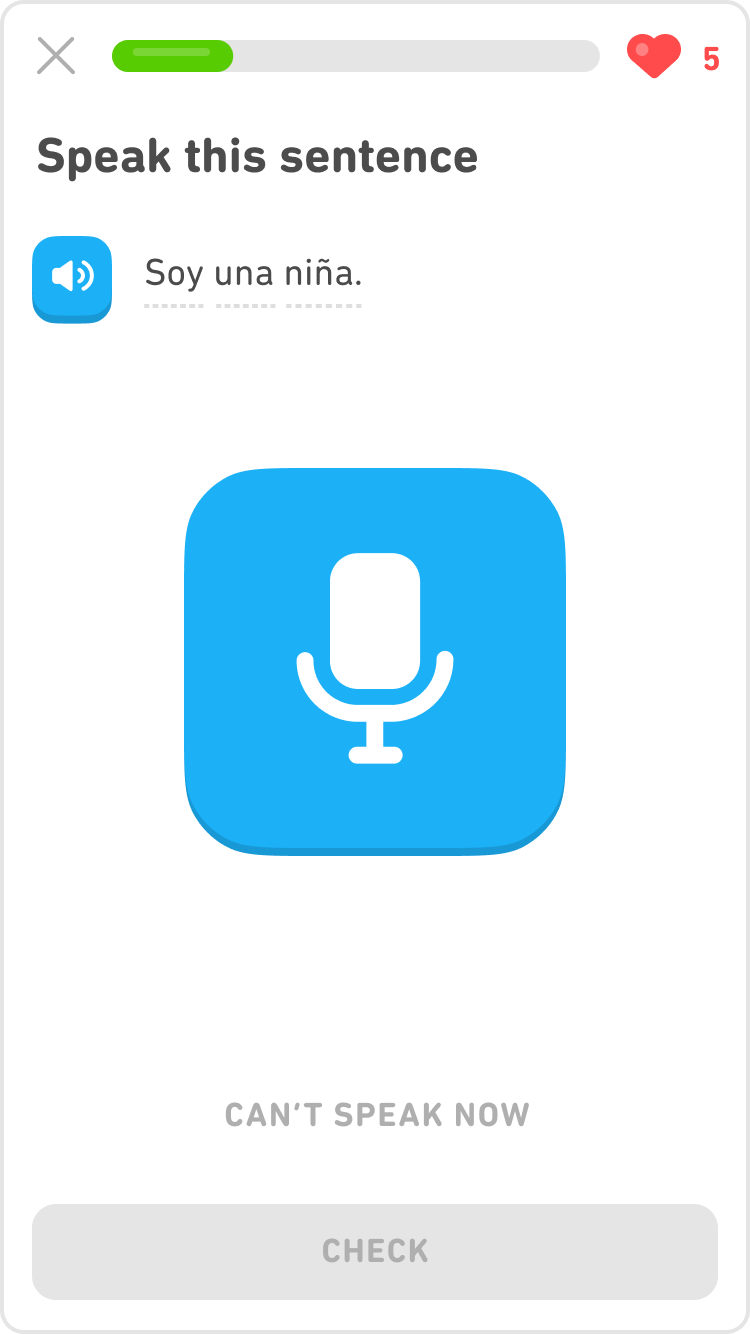
Von Ahn said Repertoire skills, which focus on how to begin a conversation, are going to launch soon. The startup is also launching audio lessons, available in French on iOS, that allow users to practice listening comprehension and speaking. Expect those exercises to radiate out to other courses in the future, if all goes well.
In addition, the company is experimenting with podcasts in Spanish, English, and French to focus on audio-only learning, a series in the works since 2017 with up to 70 million downloads across all episodes. Duolingo podcasts combine story telling with language learning: a host goes through a story in slow Spanish, French or English, and then repeats it in the listener’s native language. This helps Duolingo introduce culture and native accents to listener. The podcast’s future expanding to all languages is ambiguous, and it represents yet another experiment for the company.
Duolingo’s new strategic initiatives
Duolingo is growing beyond language learning into several auxiliary new projects that may represent significant revenue streams in the years to come.
The Duolingo English Test (DET), which spun out from a hackathon project by Settles in 2014, is an online certification exam that tests language proficiency. The score is often used to help with college admissions, which is mostly monopolized by in-person tests such as the TOEFL, which often have inconvenient, hard-to-reach testing locations. Unlike the TOEFL, the DET is a one-hour exam that can be done anywhere on a desktop with results in two days. It costs $49 to take.
Much of Duolingo’s pandemic success last year was derived from the DET. Prior to 2020, 1,000 schools accepted the DET for admissions, but after the pandemic shut down most in-person testing centers, more than 2,000 new schools began accepting the DET. There was also a 2,000% increase in test-taker volume from 2019 to 2020.
The DET attracts a different, mainly international audience for Duolingo, who can also potentially become customers of the app as they refine their skills for the test.
Long term, the company could use the patterns of mistakes that test takers make on the DET to revamp the English courses on the Duolingo app, said Jennifer Dewar, director of strategic engagement for the DET. She added that the ambition is for users to be able to use “the app to learn English all the way up through [an advanced level] and then be able to assess.” Right now, Duolingo’s English course can only train users to a low-intermediate level based on international language learning guidelines.
Outside of its test, the company launched Duolingo ABC during the pandemic, which is a free app focused on English literacy for kids aged three to six. Cammie Dunaway, chief of marketing, illustrated how Duolingo “took the hard path and started with a bunch of products where we couldn’t copy a lot of key learnings from the main app.”
For example, the ABC app is advertisement-free. The app also relies more on voice-over instead of text since kids using the app either can’t read or have limited reading capabilities. ABC also doesn’t employ engagement hooks such as streaks or competitive leaderboards, which means Duolingo needs to innovate on how it makes the app experience just as engaging for kids as its main app is for adults.
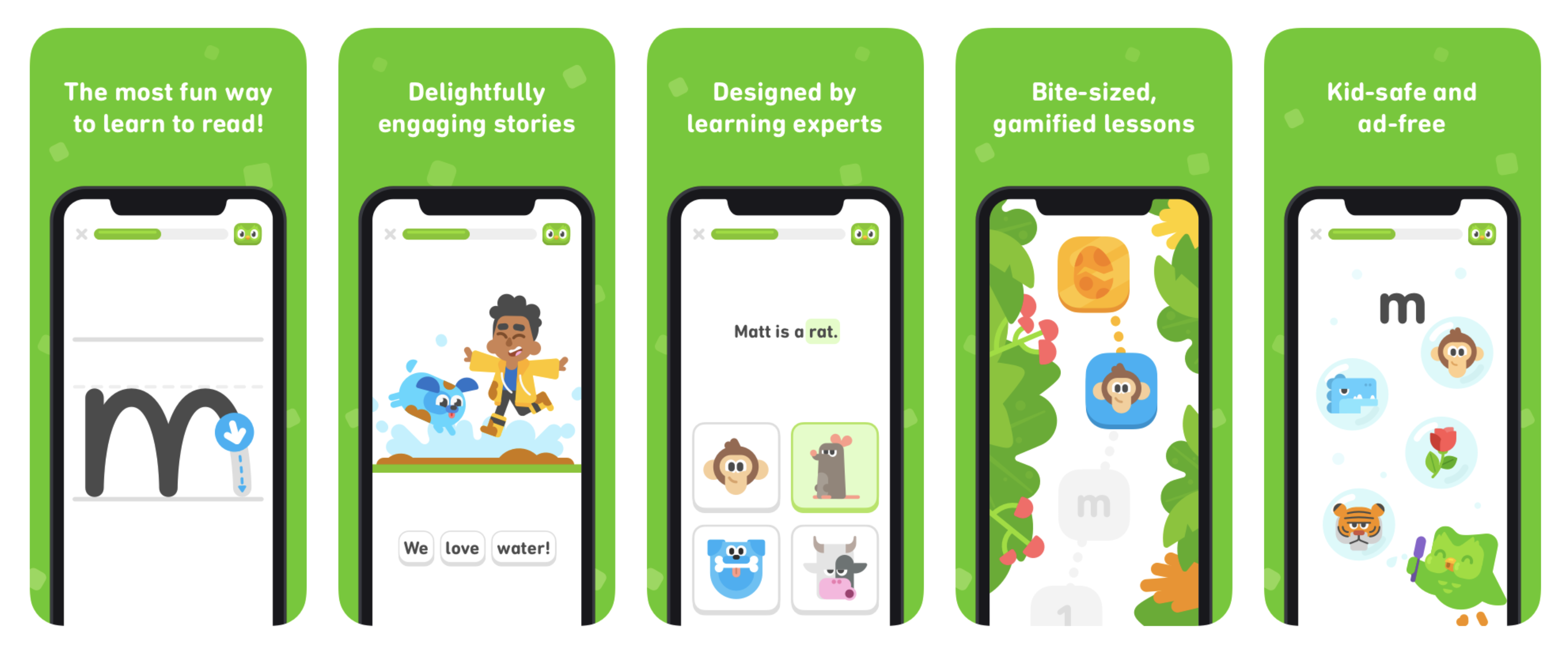
The legacy of language
Duolingo set out to change the way people learn languages, and it has done that for hundreds of millions of people, with award-winning UX to the gamification standards it has created for the industry. The company’s second act is in motion as it seeks to improve efficacy and invent new products that can bring more users under its umbrella. The startup is reportedly pursuing an IPO in the next few quarters.
That impressive growth hasn’t come without struggles though. Duolingo is defined by a number of tensions, whether user engagement versus education or bringing in revenue while also keeping the core experience free. The startup has opinions about what most see as too meta to touch in tech, such as the possibility of a learning metric and a boundary on what is fair and unfair addiction in gaming.
Success for Duolingo is nuanced. If you think of it as an edtech company, success is turning Duolingo from a five-minutes-a-day habit into a forever habit that can truly change income potential. If you think of it as a consumer subscription technology startup, success is creating an engaging place that people want to regularly come to. The truth is, Duolingo is a little bit of both.
Von Ahn thinks that the biggest and most important thing for Duolingo going forward is continuing to keep people motivated with more pedagogy introduced into the experience. He agrees that there is work to do. And in his eyes, there always is when trying to change the way education looks and feels and sounds and winks.
“We’ve hired some of the smartest people in the world, and we’ve been working on it for 10 years,” von Ahn said. “This is not easy.”
Updated May 3, 2021 to include more information about the podcast experiment at Duolingo.
Duolingo EC-1 Table of Contents
- Introduction
- Part 1: Origin story
- Part 2: Product-led growth strategy
- Part 3: Monetization
- Part 4: New initiatives and future outlook
Also check out other EC-1s on Extra Crunch.
Updated May 4, 2021 with new numbers on Busuu users.
